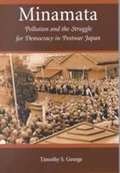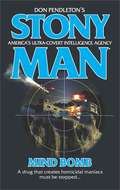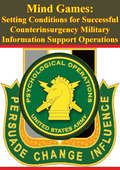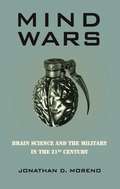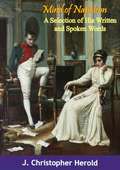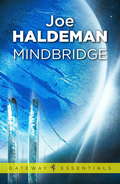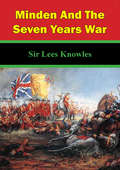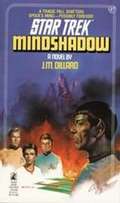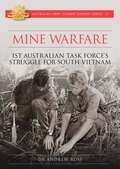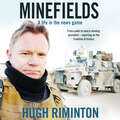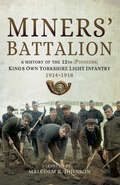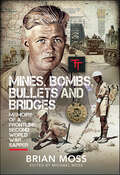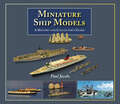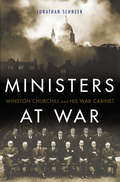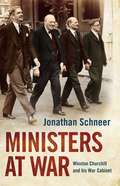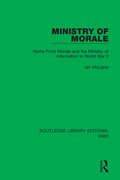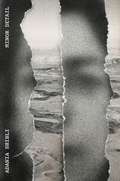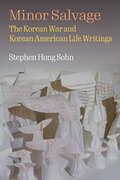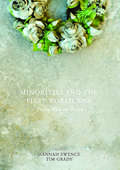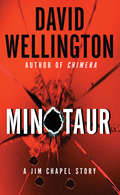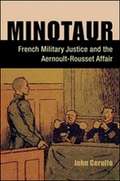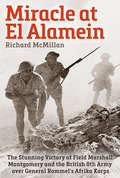- Table View
- List View
Minamata: Pollution and the Struggle for Democracy in Postwar Japan
by Timothy S. GeorgeNearly forty years after the outbreak of the “Minamata Disease,” it remains one of the most horrific examples of environmental poisoning. Based on primary documents and interviews, this book describes three rounds of responses to this incidence of mercury poisoning, focusing on the efforts of its victims and their supporters, particularly the activities of grassroots movements and popular campaigns, to secure redress.
Mind Bomb
by Don PendletonSTONY MAN Operating under covert Presidential directives, the elite black ops group known as Stony Man is bound by honor to risk the ultimate price to uphold freedom.MENTAL MELTDOWNFollowing a series of suicide bombing attacks along the U.S.-Mexican border, the relatives of a dead female bomber attack Able Team, descending from social to homicidal in a matter of seconds. Clearly these bombings are far more than random killings. Searching for an answer to the seemingly psychotic episodes, the black ops group discovers someone is controlling these people's minds with a new drug that leaves them catatonic or dead, after first giving them the extraordinary urge to kill. While Able Team follows leads in the U.S., Phoenix Force heads to investigate similar bombings in the Middle East. With numerous civilians already infected by the drug, they must eliminate the source before the body count of unwilling sacrifices mounts.
Mind Games: Setting Conditions for Successful Counterinsurgency Military Information Support Operations
by Major Henry B. Davis IVThe purpose of this study is to determine what actions can be taken by American military forces to set conditions for conducting effective Military Information Support Operations (MISO) campaigns in counterinsurgency (COIN) conflicts. To find these actions, hypotheses built upon tenets found in American military Psychological Operations (PSYOP) doctrine were compared to empirical observations of PSYOP conducted in three COIN case studies from the 1950s and 1960s. Because COIN literature is ripe with assertions, such as Dr. Kalev I. Sepp's, that "effective, pervasive psychological operations (PSYOP) campaigns" are inherent in successful COIN operations, it is ironic that few works discuss specific recommendations regarding the design and conduct of such campaigns. This study begins filling this literature gap by showing that MISO relationship to other operations holds greater significance in effective MISO campaign design than internal details such as the level of centralization. This finding supports contemporary calls for a more unified group of inform and influence practitioners within the United States military, as well as calls for the United States government to draft a National Information Strategy to better leverage this important element of national power.
Mind Wars
by Jonathan D. Moreno"One of the most important thinkers describes the literally mind-boggling possibilities that modern brain science could present for national security." -LAWRENCE J. KORB, former US Assistant Secretary of Defense"Fascinating and frightening." -Bulletin of the Atomic ScientistsThe first book of its kind, Mind Wars covers the ethical dilemmas and bizarre history of cutting-edge technology and neuroscience developed for military applications. As the author discusses the innovative Defense Advanced Research Projects Agency (DARPA) and the role of the intelligence community and countless university science departments in preparing the military and intelligence services for the twenty-first century, he also charts the future of national security.Fully updated and revised, this edition features new material on deep brain stimulation, neuro hormones, and enhanced interrogation. With in-depth discussions of "psyops" mind control experiments, drugs that erase both fear and the need to sleep, microchip brain implants and advanced prosthetics, supersoldiers and robot armies, Mind Wars may read like science fiction or the latest conspiracy thriller, but its subjects are very real and changing the course of modern warfare.Jonathan D. Moreno has been a senior staff member for three presidential advisory commissions and has served on a number of Pentagon advisory committees. He is an ethics professor at the University of Pennsylvania and the editor-in-chief of the Center for American Progress' online magazine Science Progress.
Mind of Napoleon: A Selection of His Written and Spoken Words
by J. Christopher HeroldThis collection of written and spoken statements of Napoleon serves not as an historical record or analysis, but as insight into the mind and character of a fascinating historical figure. It demonstrates the luminous strength and almost supernatural power of Napoleon's mind, displaying an exceptional energy in thought as well as action.The selections are edited and organized topically to offer a broad range of subjects--from "The Human Heart" to "The Art of War"--and to establish a coherent, unified pattern, providing a fresh perspective on the genius of Napoleon.The sources used fall into three categories: (1) Napoleon's writings, including autograph manuscripts and dictations of letters, orders, decisions, bulletins, proclamations, newspaper articles, memoirs, commentaries, etc.; (2) Napoleon's oral opinions as given at the Conseil d'Etat, including stenographic transcripts, official minutes, and unofficial notes taken by various councilors; (3) recorded conversations and reminiscences of Napoleon's contemporaries from about 1800 to 1821.
Mindbridge (Gateway Essentials #75)
by Joe HaldemanJacque LeFavre is a tamer - a member of one of the tough and honed exploration teams that, since the dramatic discovery of the Levant-Meyer Translation, humankind has been able to send to the stars. And Jacque's first world is the second planet out from Groombridge 1618. It isn't an especially promising place; the planets accompanying small stars rarely pan out. But the strange and mysterious creature that Jacque and his colleagues find there, with its gift of telepathy, leads to contact with the alien and enigmatic L'vrai, and confronts humankind with an awesome opportunity - and appalling danger.
Minden And The Seven Years War
by Sir Lees KnowlesDuring the Seven Years War, British troops had been committed sparingly to continental Europe, the English war effort being made overseas in conjunction with the preeminent Royal Navy. However in 1759 the British troops under Ferdinand of Brunswick would achieve a remarkable victory against the French army at the battle of Minden.The battle began with a duel of guns on the wings of the battleline; after an indecisive battering Ferdinand ordered the division containing the British regiments to advance. In a misunderstanding of their orders the British regiments advanced swiftly on the centre of the French army, which was held by cavalry. Battered at close range by French guns the British soldiers grimly held on despite repeated French cavalry charges; in an echo of Cressey the flower of French chivalry was laid low by dogged British vollies. Once Ferdinand saw the penetration of the French lines and the wrecked French cavalry he ordered a general advance which rapidly put the French army to flight earning one the greatest victories of the entire war.In this short volume written by the renowned historian Sir Lees Knowles, are recounted the valiant deeds of the six British regiments that smashed all before them, a victory that is commemorated to this day.
Mindshadow (Star Trek: The Original Series #27)
by J.M. DillardA thrilling Star Trek: The Original Series adventure starring Captain Kirk, Spock, and more.The tranquil planet of Aritani has suddenly come under attack by a vivious and unknown enemy. The USS Enterprise rallies to the scene, only to plunge into a deadly nightmare: Spock is found mysteriously injured, his mental powers crippled and weak, and Kirk uncovers an evil Romulan plot—with a cunning double agent in the middle. As Spock begins to regain his memory, Kirk strives to expose the agent. But only Spock's knowledge can stop the Romulans from controlling the universe!
Mine Warfare: 1st Australian Task Force's struggle for South Vietnam
by Andrew RossMine warfare, in its various forms, is a favoured weapon used by insurgents against government forces. By June 1966, when the 1st Australian Task Force (1ATF) arrived in Phuoc Tuy Province, South Vietnam, the Viet Cong and People&’s Army of Vietnam forces were well entrenched in the province and used mines extensively. The mine campaign risked few enemy lives and was a powerful statement to everyone, including civilians, that the Viet Cong were still in the war and not a spent force. The intense patrolling practised by 1ATF inevitably put its men in close contact with enemy mines. Indeed, 1ATF suffered more casualties from the Viet Cong mine warfare campaign than from any other single cause, yet enemy casualties were minimal. So why did the enemy mine campaign collapse in the period July to December 1970 and continue its rapid decline until 1ATF ended combat operations in September 1971? Counterinsurgency has been described as a competition in learning and, facing a well-organised mine campaign against them, 1ATF learned and adapted to the enemy&’s mine warfare techniques. Supported by statistical analyses of operational research data, this book details the complex tactics adopted by 1ATF to eventually defeat the Viet Cong mine campaign, and how enemy forces were reduced to a negligible military presence in Phuoc Tuy Province.
Mine to Save (Rescue Ops #3)
by Diana Gardin"No one does Romantic Suspense like Diana Gardin." -Susan Stoker, New York Times bestselling authorA sexy and suspenseful standalone in the Rescue Ops series.This time, he'll have to save one of his own...I make everything complicated. Instead of being content owning a bar, I accept a job with the Rescue Ops team at Night Eagle Security. Apparently, guys with Special Forces explosives training are hard to come by. And instead of hooking up with one of the many women who flirt with me, I have to fall for hacker Sayward Diaz. Not only is she one of my new co-workers, she's also just become my first assignment. Like I said, complicated.When Sayward's father dies and his secret ties to the Colombia cartel put her in danger, it's my job to keep her safe at all costs. For a woman who's more comfortable with computers than humans, she's not exactly thrilled to have me as her bodyguard--or by our undeniable spark. And with threats coming at us from all sides, I can't let our attraction compromise her safety. Because if I do, my first mission might be my last.The Rescue Ops series: Sworn to ProtectPromise to DefendMine to Save
Minefields: A life in the news game - the bestselling memoir of Australia's legendary foreign correspondent
by Hugh RimintonMinefields is a compelling exploration of a foreign correspondent's life - proof of Hugh's belief that 'if you go looking for trouble, you'll probably find it'.Over nearly forty years as a journalist and foreign correspondent, Hugh Riminton has been shot at, blown up, threatened with deportation and thrown in jail. He has reported from nearly fifty countries, witnessed massacres in Africa, wars and conflicts on four continents, and every kind of natural disaster.It has been an extraordinary life. From a small-town teenager with a drinking problem, cleaning rat cages for a living, to a multi-award-winning international journalist reporting to an audience of 300 million people, Hugh has been a frontline witness to our times. From genocide in Africa to the Indian Ocean tsunami, from wars in Iraq and Afghanistan to slave-buying in Sudan, Hugh has seen the best and worst of human behaviour. In Australia, he has covered political dramas, witnessed the Port Arthur massacre and the Thredbo disaster and broken a major national scandal. His work helped force half a dozen government inquiries. His story is entertaining, deeply personal and quietly wise.'An impressive career. His story is a triumph of substance over style.' Sydney Morning Herald'Hugh is an icon of Australian journalism' Michael Ware, former Iraq correspondent for TIME and CNN
Mineral Requirements for Military Personnel: Levels Needed for Cognitive and Physical Performance During Garrison Training
by Institute of Medicine of the National AcademiesThe National Academies Press (NAP)--publisher for the National Academies--publishes more than 200 books a year offering the most authoritative views, definitive information, and groundbreaking recommendations on a wide range of topics in science, engineering, and health. Our books are unique in that they are authored by the nation's leading experts in every scientific field.
Miners' Battalion: A History of the 12th (Pioneers) King's Own Yorkshire Light Infantry 1914–1918
by Malcolm Keith JohnsonThe true nature and functions of a pioneer battalion were never fully understood during the war either by military or laymen. Pioneers pioneers, mused a red-hatted Staff Captain to me the other day. Sort of labor battalion, arent you? We sure are! I agreed. These words, written by Captain R. Ede England, who served with 12th King's Own Yorkshire Light Infantry during the whole of the Great War, are as true today as they were when he wrote the original history of the battalion in the early 1920s. Little is known, or understood, of the contribution made by the many thousands of men who served with the original Pioneer battalions. Building and repairing roads, bridges, railway lines, gun emplacements, and laying barbed wire to protect the Front Line, were just some of the tasks that they performed on a regular basis. Fortunately, the subject of the British Armys logistical support in the war zone during the new industrialized warfare that developed between 1914 and 1918 is now being examined in greater detail. Miners Battalion, A History of the 12th (Pioneers) Kings Own Yorkshire Light Infantry 1914-1918 follows the battalion throughout the war and shows how the men, mainly Yorkshire miners, applied their civilian skills to the purposes of war. It also reveals that in 1918, when forced to fight as infantrymen, the battalion performed with distinction, gaining the nickname, 'the Yorkshire Guards'.
Mines, Bombs, Bullets and Bridges: A Sapper's Second World War Diary
by Brian MossSoldiers’ first-hand accounts of Second World War active service invariably make inspiring and exciting reading but Mines, Bombs, Bullets and Bridges is exceptional for several reasons. First, Brian Moss’s role as a bomb disposal specialist was especially hazardous. Secondly, he was in the thick of the action from the start, dealing with unexploded ordnance during the London blitz. He was then deployed as a frontline sapper to North Africa and onto Sicily before landing on Gold Beach on D-Day. Despite many close calls he was relatively unscathed until taken out by a butterfly bomb at Nijmegen. Fortunately, despite serious injury he lived, quite literally, to tell the tale but his war was over. While the author’s graphic account compares favorably with the very best wartime memoirs, it also has a unique element, namely examples of his outstanding artistic skill. It is truly remarkable that he not only managed to produce so many fine works under combat conditions and that he was able to draw such accurate maps from memory. His sketches and paintings bring a special dimension to this story. What a privilege it is to feast on the words and images created by this exceptionally brave and talented man.
Miniature Ship Models: A History and Collector's Guide
by Paul JacobsThis beautifully illustrated history of miniature ship models features hundreds of color photographs of some of the finest miniature ships ever built. In this informative book, model expert Paul Jacobs traces the history of modern models back to their use as identification aids by the military in World War I. Miniature Ship Models is the first serious history of the industry's development, the commercial rise and fall of companies, and the advancing technology that produced ever more detailed and accurate replicas. Writing with collectors in mind, Jacobs looks at the products of each manufacturer, past and present, rating their quality and suggesting why some are more collectible than others. Jacobs also addresses subjects of interest to model makers, such as painting, modifying and diorama settings. Illustrated throughout with many of the finest examples of the genre, the combination of fascinating background information with stunning visual presentation will make this book irresistible to any collector or enthusiast.
Ministers at War: Winston Churchill and His War Cabinet
by Jonathan SchneerIn May 1940, with France on the verge of defeat, Britain alone stood in the path of the Nazi military juggernaut. Survival seemed to hinge on the leadership of Winston Churchill, whom the King reluctantly appointed Prime Minister as Germany invaded France. Churchill’s reputation as one of the great twentieth-century leaders would be forged during the coming months and years, as he worked tirelessly first to rally his country and then to defeat Hitler. But Churchill--regarded as the savior of his nation, and of the entire continent--could not have done it alone. As prize-winning historian Jonathan Schneer reveals inMinisters at War, Churchill depended on a team of powerful ministers to manage the war effort as he rallied a beleaguered nation. Selecting men from across the political spectrum--from fellow Conservative Anthony Eden to leader of the opposing socialist Labor Party Clement Attlee--Churchill assembled a War Cabinet that balanced competing interests and bolstered support for his national coalition government. The group possessed a potent blend of talent, ambition, and egotism. Led and encouraged by Churchill, the ministers largely set aside their differences, at least at first. As the war progressed, discord began to grow. It reached a peak in 1945: with victory seemingly assured, Churchill was forced by his Minsters at War to dissolve the Government and call a General Election, which, in a shocking upset, he lost to his rival Attlee. Authoritatively recasting our understanding of British high politics during World War II, Schneer shows that Churchill managed the war effort by managing his team of supremely able yet contentious cabinet members. The outcome of the war lay not only in Churchill’s individual brilliance but also in his skill as an executive, and in the collective ability of men who muted their personal interests to save the world from barbarism.
Ministers at War: Winston Churchill and his War Cabinet
by Jonathan SchneerBritain's wartime cabinet brought together Conseratives, Labour and independent in a coalition of political titans, including Bevan, Atlee, Beverbrook, Morrison, Eden and Cripps. This is the gripping story of how they governed and won. Under Churchill's leadership they overcame political and personal differences in service of the national interest in a time of great crisis.But behind closed doors there were rivalries and intrigues, as well as unexpected friendships - brought to life here through Jonathan Schneer's original research and vivid writing. With fascinating portraits of the figures involved and sharp analysis of the political ups and downs, Ministers at War is a unique and essential perspective on World War II.
Ministry of Morale: Home Front Morale and the Ministry of Information in World War II (Routledge Library Editions: WW2 #17)
by Ian McLaineThis book, first published in 1979, is an analysis of the wartime Ministry of Information, responsible for the maintenance of public morale. How was it that British morale remained high, yet the department responsible was so bad? This book examines the domestic work of the Ministry and offers an unprecedented insight into the mind of both government and people during the war. It answers key questions: How did a government department assess and set about maintaining morale? How did it handle the social and political questions associated with morale – post-war social reform, press freedom and censorship, the nature of the Soviet regime? How sound in fact was civilian morale, on the basis of the secret Wartime Intelligence reports then available? One of the most fascinating aspects of this book is the Ministry’s constant internal debate on how its responsibilities should best be carried out. It is a key work of research on the political, psychological and mass communications problems facing a society at war.
Minor Detail
by Adania ShibliA searing, beautiful novel meditating on war, violence, memory, and the sufferings of the Palestinian people Minor Detail begins during the summer of 1949, one year after the war that the Palestinians mourn as the Nakba—the catastrophe that led to the displacement and exile of some 700,000 people—and the Israelis celebrate as the War of Independence. Israeli soldiers murder an encampment of Bedouin in the Negev desert, and among their victims they capture a Palestinian teenager and they rape her, kill her, and bury her in the sand. Many years later, in the near-present day, a young woman in Ramallah tries to uncover some of the details surrounding this particular rape and murder, and becomes fascinated to the point of obsession, not only because of the nature of the crime, but because it was committed exactly twenty-five years to the day before she was born. Adania Shibli masterfully overlays these two translucent narratives of exactly the same length to evoke a present forever haunted by the past.
Minor Salvage: The Korean War and Korean American Life Writings
by Stephen Hong SohnThe Korean War, often invoked in American culture as “the forgotten war,” remains ongoing. Though active fighting only occurred between 1950 and 1953, the signing of an armistice resulted in an infamous stalemate and the construction of the Korean Peninsula’s Demilitarized Zone. Minor Salvage reads early Korean American life writings in order to explore the admittedly partial ways in which those made precarious by war seek to rebuild their lives. The titular phrase “minor salvage,” draws on different valences of the word salvage which, while initially associated with naval recovery efforts, can also be used to describe the rescue of waste material. Spurred by the stories told and retold to him by his parents Soon Ho and Yunpyo, Sohn enacts minor salvage by reading overlooked early Korean American life writings penned by Induk Pahk, Taiwon Koh, Joseph Anthony, and Kim Yong-ik alongside a later generation of life writings authored by Sunny Che and K. Connie Kang. In the context of the Korean War, Sohn argues, life writings take on a crucial political orientation precisely because of the fragility attached to refugees, civilians, children, women, and divided family members. To depict the possibility of life is to acknowledge simultaneously the threat of death, violence, and brutality, and in this regard, such life writings are part of a longer genealogy in which marginalized communities find representational power through the creative process.
Minorities and the First World War
by Hannah Ewence Tim GradyThis book examines the particular experience of ethnic, religious and national minorities who participated in the First World War as members of the main belligerent powers: Britain, France, Germany and Russia. Individual chapters explore themes including contested loyalties, internment, refugees, racial violence, genocide and disputed memories from 1914 through into the interwar years to explore how minorities made the transition from war to peace at the end of the First World War. The first section discusses so-called 'friendly minorities', considering the way in which Jews, Muslims and refugees lived through the war and its aftermath. Section two looks at fears of 'enemy aliens', which prompted not only widespread internment, but also violence and genocide. The third section considers how the wartime experience of minorities played out in interwar Europe, exploring debates over political representation and remembrance. Bridging the gap between war and peace, this is the ideal book for all those interested in both First World War and minority histories.
Minotaur
by David WellingtonSomeone is smuggling Russian guns into the United States to arm domestic terrorists, and it's up to Special Forces veteran Jim Chapel to uncover who is behind the plot. The prime suspect is Ygor Favorov, a notorious Russian operative who defected just before the fall of the Soviet Union. But exposing a billionaire double agent is far from easy, and Chapel must fight his way through a small army of security guards to confront the Russian and defuse a secret that could lead to war between the United States and Russia.
Minotaur: French Military Justice and the Aernoult-Rousset Affair
by John CerulloOn February 11, 1912, an estimated 120,000 people in Paris participated in a ceremony that was at once moving and macabre: a public procession to P\u00e8re Lachaise Cemetery, where the remains of a soldier named Albert Aernoult would be incinerated after a series of angry speeches denouncing the circumstances of his death. This ceremony occurred at a pivotal point in the \u201cAernoult-Rousset Affair,\u201d a three-year agitation over the practice of French military justice that was labeled a \u201cproletarian Dreyfus Affair.\u201d Aernoult had died in one of the French ArmyÆs Algerian penal camps in the summer of 1909, allegedly at the hands of his officers. His death came to the attention of the public through the intervention of a fellow prisoner, a career criminal named \u00c9mile Rousset, who provoked prosecution in a military court in order to launch his own JÆaccuse against camp officers. RoussetÆs charges seemed to be bearing fruit until he himself was indicted for murder, whereupon the entire Affair took on a new intensity.CerulloÆs lively, suspenseful account of this dramatic story, which has never been fully told, will become the standard. In the current era of special military courts, commissions, and prisons, the subject of military justice is an urgent one. Minotaur will interest historians of modern France, military historians and students of military justice, and legal scholars, while also appealing to general readers of modern European history and military law.
Miracle at Belleau Wood: The Birth Of The Modern U.S. Marine Corps
by Alan AxelrodNow in paperback!Military Book Club® Main Selection History Book Club® Featured Alternate*The battle that transformed a group of common soldiers into the modern-day Marine CorpsMiracle at Belleau Wood begins in June 1918 at Les Mare Farm in France with just 200 U.S. marines, who spilled their blood to prevail against impossible odds, resisting an overwhelming German force of thousands and turned the battle back against the enemy, saved Paris, saved France, and saved the Allied hope of victory. Called &“the Gettysburg of the Great War&” by many at the time, it rescued America and its allies from almost certain defeat. This book tells the riveting story of the modern marines as America&’s fiercest and most effective warriors, the world&’s preeminent fighting elite. Miracle at Belleau Wood is the story of an epoch-making battle--a battle that elevated the Corps to legendary status and forever burned them into the American imagination. Praise for Miracle at Belleau Wood&“Axelrod brings us back vividly to the shocking casualties of &‘the war to end all wars.&’&”—Bing West, author of No True Glory, former Assistant Secretary of Defense&“Alan Axelrod has perfectly captured the embodiment of U.S. Marines and their unparalleled Esprit de Corps. . . . A must read!&”—Jay Kopelman, author of the best-selling From Baghdad with Love&“Axelrod is one of America&’s great military historians. He&’s done it this time with riveting non-stop action that reads like the best of Hemingway&’s frontline reports plus the Marine Corps novels of W.E.B. Griffin. Axelrod pushes you right into the action, onto the battlefield, and never lets up.&”—Paul B. Farrell, JD, PhD, syndicated columnist for Dow Jones&’s MarketWatch, former Staff Sergeant in the US Marine CorpsPraise for Patton: A Biography&“Like Patton at his best: polished, precise, and persuasive.&”—Kirkus Reviews
Miracle at El Alamein
by Richard McMillanMiracle at El Alamein, first published in 1943 as Mediterranean Assignment is British journalist Richard McMillan's first-hand account of World War Two in North Africa and Greece during 1940-1942. He was the first war correspondent to be licensed by the British Expeditionary Forces (BEF), and accompanied British forces in most of their campaigns in the European and African theaters of the war. He details the strategy, tactics, and on-the-ground fighting of Field-Marshal Montgomery's forces versus those of German General Erwin Rommel through the early set-backs to the final defeat of the Afrika Korps at El Alamein. McMillan's clear and descriptive writing make the conflict in the Mediterranean region understandable, while bringing to life the experiences of the fighting soldier as well. The role of Allied air forces and navies in the Mediterranean theater are also detailed, with vivid descriptions of the author's experiences while on-board aircraft or ships.McMillan, a long-time European United Press correspondent, later went on to land with British troops in the Normandy invasion France. While covering the assault on Cherbourg he was wounded in the back by shrapnel. After a short time in England to recovery he returned to France and reported on the liberation of Paris, and remained with Allied troops as they advanced on the Rhine and into Germany.
